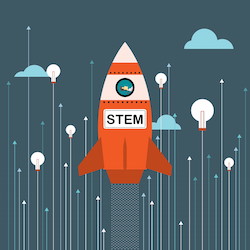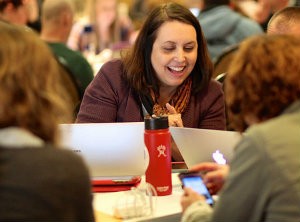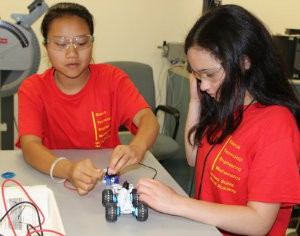4 ESSA-Friendly Ideas for STEM’s Breakout Year
A MiddleWeb Blog
 Goodbye to 2015
Goodbye to 2015
I have said my nostalgic goodbyes to 2015. As yet another year slipped into history, I took a quick look back at some of the technologies that emerged as the hottest sellers in 2015.
They include digital engineering innovations such as drones, photo printers that attach to smartphones, panoramic video cameras, interactive Star Wars characters, smarter smart TVs, game consoles, tablets, smartphones, smartwatches, and actionable analytic devices that can instantly convert an abundance of raw data into immediate actions.
I got one of those devices myself. I can ask it anything and it gives me an instant response – including playing my favorite music, turning off my lights, or simply answering any question I ask about anything. I know – that’s a normal, ho-hum observation for many of you, but it’s truly jaw-dropping for me – someone who was born when a television controlled by vacuum tubes was the height of personal technology and the envy of the neighborhood.
Our Digital World
We now live in a digitally dependent world – a STEM world. (I must note, as always, that digital technology is only one type of technology. Even a paper clip is technology – a device invented and engineered to solve a problem.) Consider . . .
• Who dreams up new technology ideas?
• Who has the know-how and skill set to make those dreams come true?
• Who looks at current technologies, recognizes ways to improve them, and knows how to make that happen?
• Who’s examining the impact of new technologies on our lives, our communities, and our nation?
Answer: the students currently graduating from our high schools and colleges and joining the workforce are primary among those who must tackle all of these challenges.
• Who is the linchpin in preparing these students for the workforce?
Answer: Smile. No pressure here, but our future depends on knowledgeable educators who are able to prepare kids to be innovative, creative, aware, and knowledgeable . . . and on schools that allow teachers to teach kids in cutting-edge ways, beginning early in the education process.
Welcome to 2016!

So how are you going to tackle the STEM challenges of 2016? In addition to the previous recommendations for teaching and implementing STEM I’ve shared in earlier blog posts, I’ll toss out these 4 ideas. You might decide to take on one or more of these as a goal for 2016 and ready yourself for the STEM explosion.
IDEA 1: I will broaden my STEM knowledge base this year.
In a world of continual learning there’s no shortage of opportunities for learning more about STEM. You might . . .
Attend a STEM conference or symposium.
Lockheed Martin is sponsoring a USA Science & Engineering Festival featuring many STEM-related events, contests, and opportunities for both teachers and students. Organizations such as the National Science Teachers Association, the American Society for Engineering Education, the International Technology and Engineering Educators Association, and the National Council for Teachers of Mathematics host regional and national conferences that emphasize STEM-focused professional learning.
Maybe you need something closer to home? Try this: type the acronym STEM into a search engine followed by the name of your state. You’ll be amazed at the number of hits, and in many cases you can find professional learning opportunities nearby. Try narrowing the search by typing in STEM + (your state) + conferences, or STEM (your state) + events. In fact, if you live near a large city, type in STEM + (city), and learning opportunities may pop up right in your back yard.
Join a professional organization.
The four listed above are excellent choices. The literature and access to people, information, and online resources keep professional learning at your fingertips.
Analyze and adjust your current STEM lessons.
Make sure the lessons are building the specific STEM skills kids need and make adjustments as needed. STEM lessons are engaging and fun, but their primary purpose is to strengthen math and science applications through engineering, and to engage students with using and creating technologies. Are your current lessons helping with those goals, as well as developing innovation and creativity? (As a FYI, keep your eyes open this spring for my book, STEM by Design, with plenty of tips and dozens of tools for successfully creating lessons and engaging students in STEM projects.)
IDEA 2: I will involve my students in STEM events outside the classroom.
Understanding how to live in a STEM world holds value for all students. All vocations today depend in some manner on the availability and use of digital technologies, and need workers who are creative, innovative, and savvy in appropriate technologies, and teamwork skills. (Feel free to give me some push-back on that statement in the Comments area.) Some ideas . . .
Expose your students to STEM in action.
Make arrangements for them to tour industries in the engineering and manufacturing sector and talk with engineers about their work. Ask engineers to come in and speak with your students about their work. Hold a career fair to make them aware of what STEM careers offer.
Make arrangements for your students to attend summer STEM camps and events.
This involves working with parents, making information available, and providing constant encouragement. You might spearhead an effort to secure funding to offset any costs. The armed services often offer summer STEM camps such as this one by the US Naval Academy. To find camps nearer you, try the STEM+ (your state) + stem camps method.
Involve your students in STEM-related competitions.
Your students may enter a local STEM fair, a science fair, a robotics competition, or similar event. Or, you may decide to host your own schoolwide STEM competition.
IDEA 3: I will publicize what’s happening in our STEM program in a new venue.
Ideas for this are plentiful and depend on your location. Perhaps you could post a STEM blog on your school website featuring both your students’ accomplishments and challenges you and your students faced. Maybe you could write a STEM column each month for a local newspaper or community online site. The sky is the limit on this one.
IDEA 4: I will look for grants to support STEM projects and activities.

What do you know about the coming ESSA tidal wave? Take a look at this article by J.F. Brown: Coalition Analysis of Key STEM Provisions in ESSA. Scroll down and note that funding will be available to support educational enrichment for students in the STEM area. Funding will also available for STEM teachers’ professional development. All this begins in the July-October 2016 window.
I hope you have a wonderful STEM year in 2016. Stay current. Stay relevant. Stay on the STEM track and hang on for a fast ride!































Great article. What is the name of the analytic device that takes raw data and turns it into immediate actions?
Grin – Sounds impressive, doesn’t it? I’m referring to Amazon Echo (aka Alexa). It really does amaze me to see the speed at which it answers most any question I answer and what actions it can perform – like turning my Hue lights on and off at my request. I’d classify Siri and Cortana as a type of analytic device.
Thanks for asking, Craig. I hope you have a great year!
Hearing all of this makes me wish I was a Science Teacher. What is going to happen in the STEM Labs sounds WONDERFUL. I’m so jealous.
Thanks Bobby. Teaching kids science was the most important job I ever had. In fact teaching is a wonderful profession.